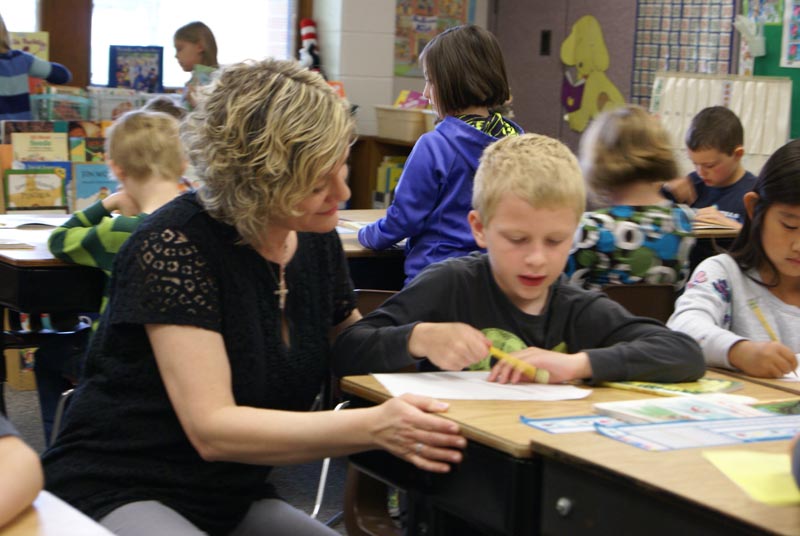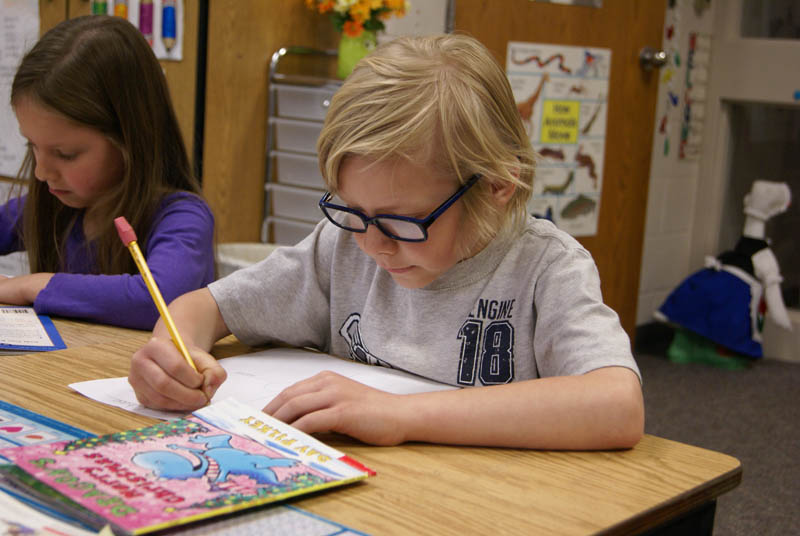Rich school, poor school, and the challenges that separate them
(Part 2 of 2) See Part 1 here: One Dearborn school soars, another stumbles and Grand Rapids cites the limits of state rankings to explain school gaps
As she was planning a field trip for her Waukazoo Elementary class recently, first grade teacher Jennifer Aalderink asked for parents to volunteer their time. Twenty-one stepped forward.
Some years ago, when she taught at nearby Pine Creek Elementary, “I was lucky if I could get one,” she said.
The difference is not so much in the commitment of parents to their children’s education as it is in money and time. Since both schools are in the West Ottawa Public Schools district, the per-pupil funding from the state is the same. The difference is in the income disparity of their parents.
Waukazoo Elementary generally serves the district’s most affluent families, including those who live in high-priced homes along the Lake Macatawa shore. If you live there, chances are one parent doesn’t need to work or can afford to take time off to volunteer at school.
Many of Pine Creek’s students come from one of Holland’s poorest neighborhoods. If you live there, it can be a struggle just to get by. Eighty-seven percent of Pine Creek’s students qualify for free or reduced-price lunches. At Waukazoo, it’s 23 percent. Fifty-seven percent of Pine Creek’s students are Hispanic, including many for whom English is a second language. Fifteen percent of Waukazoo’s students are Hispanic
MORE COVERAGE: “How one West Michigan school district is closing reading gaps for poor, Hispanic students”
Yet language and income are not the only differences.
“I’ll tell you what the difference is,” Aalderink said of the Waukazoo students. “These kids are coming in here ready to learn. As a first grade teacher, you can tell when they come in who’s been read to at home.”
Studies show that white, more educated mothers are more likely to read to their young children than poor, African-American or Hispanic mothers. A recent Bridge article showed that fewer than 1-in-10 at-risk Michigan children are benefitting from programs that could help low-income parents boost their children’s early literacy skills.
In her Waukazoo Elementary classroom, six parents volunteer on a regular schedule to help students with their reading. Aalderink looked at her class of 26 students and counted only four who live in single-parent homes, well below the national average of 35 percent.
“The population we serve here tends to be middle and upper class,” Waukazoo Principal Ami Taylor said. “I think our kids come to us with a lot of skills. Our kids come to us with that experience of books in their bedrooms and books on the shelves.”
Despite their initial disadvantages, 68 percent of Pine Creek’s fourth-grade students were proficient in reading on the statewide MEAP test given in the 2013-2014 school year, only slightly below the statewide average of 70 percent, though well below the 88 percent for Waukazoo’s fourth graders.
Still, given the challenge, Pine Creek has made considerable gains for its students, which are reflected in Bridge’s Academic State Champs rankings. Though Pine Creek’s students generally scored lower on standardized tests than Waukazoo, it ranked 33rd out of 1,210 elementary schools in the state in the Academic State Champs rankings, which are weighted to account for the poverty level of each school’s student population. .
Raising reading for all
The nine elementary schools in West Ottawa use periodic reading tests to assign students to one of three skill levels. Those in tier three get the most help, while those in tiers two and one need less help. “The goal is to get all students into tier one,” Taylor said.
Districtwide, as students move into the higher grades, the gap in reading ability, particularly between white and Hispanic students, narrows until it virtually disappears in eighth grade.
Because many of her students come from families that emphasize reading, “I think some would say we have it easier,” Taylor said of Waukazoo. “We still have to make them grow. We have to raise the bar for every student.”
Aalderink, the first-grade teacher at Waukazoo, pointed to a boy in her class, whose parents insisted at the beginning of the year that he couldn’t read and didn’t like school. By the end of first grade he was able to read aloud and said he enjoys learning.
Other students sat at their desks reading “Just Right Books” of various skill levels that they selected from the many on the classroom’s shelves.
“If you can read it, it’s a Just Right Book,” explained Kallyn Gaul, 7, as she filled out a story map, answering questions about the characters and plot.
In a classroom down the hall, the atmosphere was different, as each student worked independently on various projects. One boy was researching rugby. Another was adding and subtracting fractions. In the hallway outside the door, two girls and a boy took turns reading passages from a book aloud. This is a Montessori classroom of second, third and fourth graders that attracts students from throughout the West Ottawa district.
The Montessori approach is less structured than a traditional classroom, allowing students more independence to work at their own pace on activities that interest them, within limits. It also emphasizes parental involvement. At Waukazoo, that’s not a problem.
By giving students and their parents more say in what they learn, “I think that the end result is the kids are more motivated,” teacher Amy Sale said. For her, it means writing separate lesson plans for each of her 20 students. “It’s more work,” she said, “but it’s worth it in the end.”
One benefit, she said, is that younger students often learn from the older students.
“The majority of these kids come in as readers,” Sale said. “The kids who come in not as readers pick it up from the other students. These older kids help pull those younger kids up.”
Fourth grader Anya Scott and second grader Anneke Hackney were working together, identifying errors in a sentence written on a board. Anya said she enjoys reading, because “it’s like opening a door to a distant world.”
That’s the kind of response Taylor, the Waukazoo principal, likes to hear. For all of her students – rich or poor, white or Hispanic – reading is the key to success in academia and life. “That’s their ticket out,” she said.
Michigan Education Watch
Michigan Education Watch is made possible by generous financial support from:
Subscribe to Michigan Health Watch
See what new members are saying about why they donated to Bridge Michigan:
- “In order for this information to be accurate and unbiased it must be underwritten by its readers, not by special interests.” - Larry S.
- “Not many other media sources report on the topics Bridge does.” - Susan B.
- “Your journalism is outstanding and rare these days.” - Mark S.
If you want to ensure the future of nonpartisan, nonprofit Michigan journalism, please become a member today. You, too, will be asked why you donated and maybe we'll feature your quote next time!


 Jennifer Aalderink, a first-grade teacher at Waukazoo Elementary, helps student Benjamin McBride with his reading.Chase Barrett, a first grader at Waukazoo Elementary, reads a "Just Right Book" and fills out a story map, answering questions about it to test his reading ability. (Bridge photo by Pat Shellenbarger)
Jennifer Aalderink, a first-grade teacher at Waukazoo Elementary, helps student Benjamin McBride with his reading.Chase Barrett, a first grader at Waukazoo Elementary, reads a "Just Right Book" and fills out a story map, answering questions about it to test his reading ability. (Bridge photo by Pat Shellenbarger) Chase Barrett, a first grader at Waukazoo Elementary, reads a "Just Right Book" and fills out a story map, answering questions about it to test his reading ability. (Bridge photo by Pat Shellenbarger)
Chase Barrett, a first grader at Waukazoo Elementary, reads a "Just Right Book" and fills out a story map, answering questions about it to test his reading ability. (Bridge photo by Pat Shellenbarger)